Take Your Dog For a Structured Walk
By Michele Welton, Dog Trainer, Breed Selection Consultant, Author of 15 Dog Books

This young Boxer is walking along nicely with his owners. No pulling on the leash or stopping to pee on trees.
A structured walk is not done as a means of exercising. It's a special leadership-building experience between you and your pup. (I recommend that he be at least 5 or 6 months old).
It's deceptively simple. Your pup simply walks beside you. Left side or right side doesn't matter, but once you've chosen a side, that's the side he should stay on for that particular walk.
- He doesn't pull on the leash.
- He doesn't drop his head to snuffle along the ground like a hound following a rabbit trail.
- He doesn't stop to go to the bathroom. Before you even put on the leash to start the walk, your dog should have been allowed to relieve himself in his own yard.
 Remember, this is not for exercise, a potty break, or a sightseeing tour. Your pup is simply going on a walk with YOU and he should pay attention to YOU.
Remember, this is not for exercise, a potty break, or a sightseeing tour. Your pup is simply going on a walk with YOU and he should pay attention to YOU.
Don't worry, depending on how far you go, there will be a chance during the walk when he can sniff around and eliminate. You'll give him that freedom when you come to a good spot for those activities. Once we start the structured walk, you'll see how that works.
But first, is your dog ready for a structured walk? Let's see....
- If you attach his leash, then stand still, does he keep the leash loose? In other words, does he hang around close enough to you that the leash doesn't get tight?
- If you sit in a chair while he's on leash, does he still keep the leash loose?
- If you stand up and walk in any direction, does he still keep the leash loose?
To do a structured walk, your pup needs to be able to walk on a loose leash.
If your pup is fine on the leash, great job! He might be ready for a structured walk. Just two more questions....
- Does he sit politely (no barking, no jumping) while you attach his leash?
- When you open the door to go outside, does he wait for your permission before going through the door?
If yes to all these questions, your pup is ready to do a structured walk.
You might be wondering why those last two questions were important. What does sitting politely and waiting for permission to go through a door have to do with going for a walk?
Only everything!
The most important part of the structured walk actually comes before you start to walk. In fact, the structured walk begins inside your house.
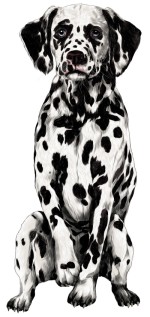 If you have trouble getting your dog to stay still while you attach the leash.... if he jumps on you... if he keeps barking... if he tries to forge through the door when you open it... he isn't ready for a structured walk.
If you have trouble getting your dog to stay still while you attach the leash.... if he jumps on you... if he keeps barking... if he tries to forge through the door when you open it... he isn't ready for a structured walk.
His body isn't calm. His state of mind isn't calm. A pup with an excited body and mind indoors will have the same excited body and mind outdoors.
These are the dogs who pull on the leash, bark at other dogs, jump on people, and get distracted by everything they see and hear, instead of paying attention to YOU.
If your pup is out of control before the walk, it will be much harder to get him under control during the walk.
So get those behaviors under control before you try a structured walk. Follow my previous articles to teach calmness and Wait at the door, and to control any barking or jumping.
Let's be optimistic and assume that your pup passed the tests, you've given him the "Okay" to go through the door, and you're both ready for a structured walk!
Once you get outside with your calm pup, give the signal for a structured walk.

Calm pupper waiting patiently for the walk to begin.
Outside, have him Sit beside you. If he doesn't know Sit yet, use a little upward pressure on the leash and downward pressure on his hindquarters to guide him into a Sit.
Right side or left side doesn't matter, but once a side is chosen, that's the side he should stay on for that particular walk.
Ready to go? Say, "Jake, heel" (or "Jake, close")
Which word to use? If you might do obedience competition in the future, use "Close" (as in "Stay close") for your structured walk, since "Heel" is typically used in competitive events to mean a very precise type of walking. If competition isn't your thing, pick either word.
"Sit" and then "Heel" (or "Close") will be the signals to your dog that you're going on a structured walk.
 During the structured walk
During the structured walk
Remember, a structured walk is not meant for exercising or pottying – it's a focused leadership-building experience between you and your pup.
So, first and foremost, you two should be together. He shouldn't be pulling. He shouldn't be walking ahead of you, looking at everything but you. The relationship you want to build is one in which you are the leader and your pup is the follower.
If he tries to forge ahead, don't forget the Opposite-Direction technique you learned in this article. It's one of the best ways to teach a dog to stay close.
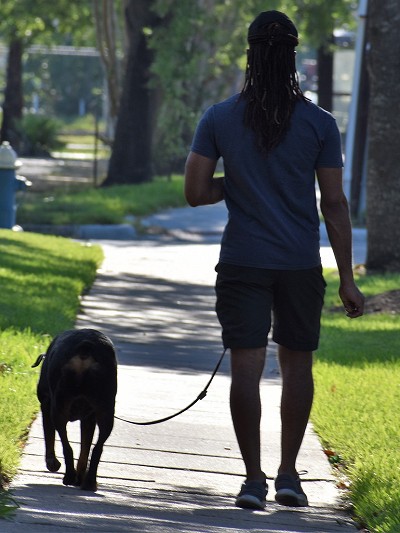
This is how your dog walks with YOU, rather than charging ahead to "more important" things.
Besides staying pretty close to your leg, your pup should keep his head up. No sniffing the ground, which is just one step removed from eating things off the ground. Stay alert. Scan the ground ahead for bits of trash and be ready to correct sniffing with "Leave it".
Your pup shouldn't be looking for places to eliminate. Dogs who want to pee against every vertical object often become obsessed with "marking their territory".
Try to choose a route that doesn't offer tempting places to eliminate. Or walk in the street, if it's safe. If your pup suddenly eliminates anyway.... oh well.
One more thing... your dog should walk quietly. He shouldn't bark or lunge at passersby or other dogs.
Break time!
Try to plan a route that includes a safe "potty break" place. Here you can say the magic release word: "Okay!"
This means your dog is free to romp about a bit, sniff the ground, find a place to pee, etc. If the area is large enough, you might be able to replace the leash with a 15- to 30-foot leash or cord so the pup has more space to stretch his legs.
Bring along a ball or toy so you can interact with your pup. Make yourself interesting, make yourself a source of fun and play, as well as a source of guidance and direction. Then your pup will gravitate to you as someone he both trusts and enjoys being with.
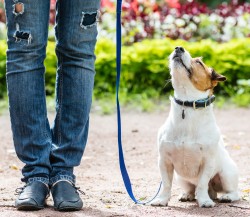 The break needn't be very long. Five or ten minutes is fine. Then get your dog sitting beside you with a loose leash. Say, "Heel" or "Close" and continue with the structured walk back to your house.
The break needn't be very long. Five or ten minutes is fine. Then get your dog sitting beside you with a loose leash. Say, "Heel" or "Close" and continue with the structured walk back to your house.
You might be wondering, "Can I sometimes take my pup for a non-structured walk? Where he can wander around on the leash, sniff the ground, and pee when he wants to?"
My answer is "Maybe."
- With puppies under 4 months old, I don't do structured walks. In fact, I don't walk puppies off their own property at this age. Until vaccinations are complete, we practice general leash walking in our own yard.
- With puppies over 5 or 6 months old, we do some structured walks, plus some non-structured walks where I simply say, "Let's go" and start walking without having the pup start out in a Sit (remember, that's one of the signals of a structured walk).
On these walks, I do allow moderate sniffing and reasonable bathroom breaks, but no pulling whatsoever. That should always be a no-no... unless you're sitting on a sled and your pup is all harnessed up for towing you across the snowy plains!
- Finally, if your pup is older than 6 months and has behavior issues, structured walks are a must for developing and reinforcing your leader-follower relationship. Until those behavior issues stop, a structured walk is the only kind of walk you should take with this pup.
My best-selling books – now available FREE on my website
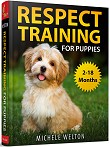 Respect Training For Puppies: 30 seconds to a calm, polite, well-behaved puppy is for puppies 2 to 18 months old. Your puppy will learn the 21 skills that all family dogs need to know. Click here to read for free.
Respect Training For Puppies: 30 seconds to a calm, polite, well-behaved puppy is for puppies 2 to 18 months old. Your puppy will learn the 21 skills that all family dogs need to know. Click here to read for free. Teach Your Dog 100 English Words is a unique Vocabulary and Respect Training Program that will teach your adult dog to listen to you and do what you say. Click here to read for free.
Teach Your Dog 100 English Words is a unique Vocabulary and Respect Training Program that will teach your adult dog to listen to you and do what you say. Click here to read for free.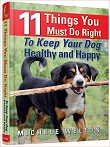 11 Things You Must Do Right To Keep Your Dog Healthy and Happy helps your dog live a longer, healthier life. Get my honest advice about all 11 Things before you bring home your new puppy, because some mistakes with early health care cannot be undone. Click here to read for free.
11 Things You Must Do Right To Keep Your Dog Healthy and Happy helps your dog live a longer, healthier life. Get my honest advice about all 11 Things before you bring home your new puppy, because some mistakes with early health care cannot be undone. Click here to read for free.
